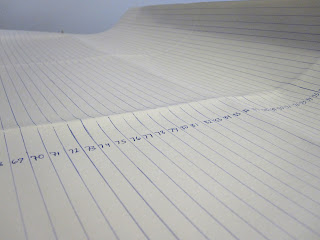I created my very first photographic weaving in high school. The weaving combines imagery of both my Jeep Cherokee engine and my backyard garden, exploring how nature inspires the technological designs around us. The left side of the weaving is predominantly garden imagery with just a few squares of engine woven in here and there. In the middle, the engine and garden begin to interweave together with birds of paradise blossoming into engine tubes. The right hand side of the weaving is almost entirely engine imagery with just a few squares of pink flowers peeking through. I created the weaving during a high school mentorship, with Santa Barbara artist
Rafael Perea de la Cabada, which culminated in a show at the Santa Barbara Contemporary Arts Forum. My good friend Sarah Patterson is now the owner of this piece which asserts itself in quite a lengthy manner on her living room wall.
 |
| "The Garden". 2000. Photographic Weaving. CLICK TO ENLARGE. |
 |
| "The Garden". DETAIL. |
 |
| "The Garden". DETAIL. |
 |
| "The Garden". DETAIL. |
Ever since that project, I had wanted to return to weaving but wasn't sure what kind of imagery to use and, to be perfectly honest, I was a bit intimidated to try the difficult task of weaving again. One day, nine years later, feeling frustrated by a bad case of artist's block, I took some old pictures and decided to make a weaving out of them, just to get my weaving juices flowing again. They were pictures I had taken in college of food coloring in milk. I made two collages of the same size, cut one collage vertically and the other one horizontally, and wove them together. It turned out great! My friend Emily Sheffield is now the proud owner of this weaving and it hangs, framed, in her law firm office.
 |
| CLICK IMAGE TO ENLARGE. "Birth of Color". Photographic Weaving. 18" x 24". |
So here I was, nine years later, hooked on weaving again. I began brainstorming different concepts that I could weave together. I wanted to weave together the macro and the micro, two things that appear similar from both from far away and from close-up, but WHAT? One idea I had was how cities look like circuit boards from an airplane, and circuit boards look like miniature cities unto themselves.
My Google Earth search for interesting city imagery led me to a visual miracle: freeway overpasses! These concrete megaliths slither over the landscape like monumental snake pits. Strands of road soar through the air, interlacing like gigantic, hovering Celtic knots, so perfect and massive in form they seem to be woven by the hands of God himself. Each overpass is a unique work of art: some are circular, some are giant Xs, some are clover shaped, cross-shaped, and some are just a jumble of big loops. I then embarked on a compulsive hunt for the biggest, coolest overpass.
I had moved on, in my mind, away from circuit boards and toward my new obsession with overpasses. I decided to do a little test. I printed out two black & white images of different L.A. overpasses and wove the two together. The result, however, was neither conceptually nor visually interesting, so I spruced up the weaving with some acrylic paint, pink and green highlighter, and a sharpie pen. THe visual effect was exciting, however, I still felt as though something was missing conceptually.
 |
| CLICK IMAGE TO ENLARGE. "Weaving Traffic", 2010. (Highway 5 & 2 interchange woven with Highway 105 & 405 interchange). Photographs, acrylic paint, highlighter, sharpie pen. 11" x 17". |
Then it occurred to me that I could weave circuit board imagery into the city-scape AROUND the freeway overpasses! This way, the final image would appear from a distance like a simple freeway overpass surrounded by urban sprawl, but up close it would be hard to differentiate what was building and what was circuit board component.
The connection, conceptually, between freeway overpasses and circuit boards became stronger in my mind as I remembered that the "Information Super Highway" is a metaphor commonly used for the internet. Cars moving on freeways can be seen as a metaphor for how information moves through circuit boards, the internet, and technology in general. Freeway overpasses make travel over long distances easy, creating a connection between LA and San Francisco for friends, family and commerce, much in the same way that the internet has connected people all over the globe. Not only was this idea visually interesting, but it was conceptually interesting as well. I was pumped.
 |
| CLICK IMAGE TO ENLARGE. "Untitled", 2010. Photographic Weaving. 20" x 48" (Images of circuit boards woven with bird's-eye view of CA-101, I-5, I-10, I-60 Junction in Los Angeles). |
My first freeway/circuit board weaving (above) was a complete success and I received rave reviews from friends and family. I decided to create a series of these large weavings, my goal being about 8-10 weavings. My next subject was the CA-101 & I-92 junction in San Mateo, right before getting on the San Mateo Bridge.
 |
| CLICK IMAGE TO ENLARGE. "Untitled", 2010. Photographic Weaving. 24" x 40". (Images of circuit boards woven with CA-101 & I-92 junction in San Mateo) |
The rest is history! Check out my other "Photographic Weavings" postings to see more current projects.



















